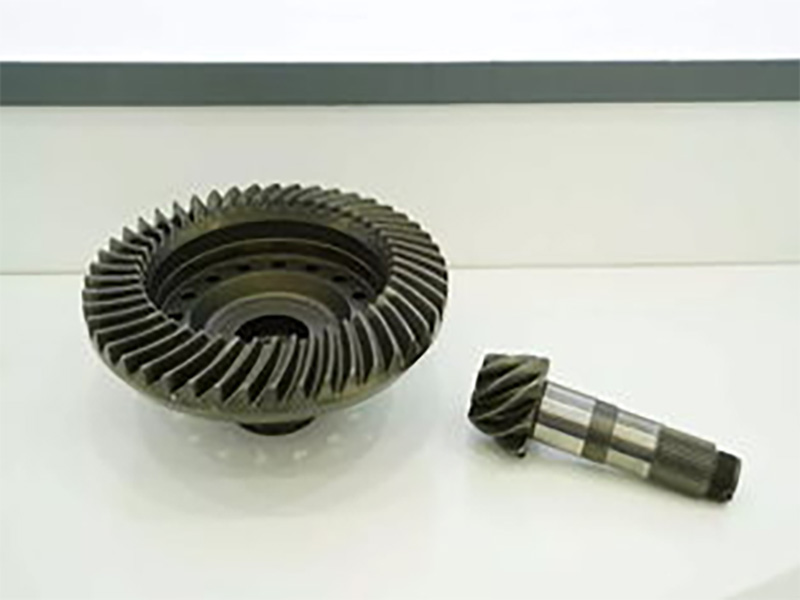

carburized gear steel(carlmrizing steel) a mechanical structural steel. It is usually a carbon steel with low carbon content (0.10% to 0.25%) and alloy steel (the main alloy elements are Cr, Ni, Mn, B, etc.). Made parts are generally used after carburizing, quenching and low-temperature tempering. Mainly used as a high surface hardness, wear resistance, the heart has a high toughness of the parts, such as gears. Commonly used carburized steel 15, 20, 20Cr, 20Mn2B, 20Cr2Ni4, 1 8Cr2Ni4W
The preheat treatment of carburized steel is usually normalized, and for high hardenability carburized steel, air-cooled quenching followed by high-temperature tempering can be used to obtain tempered sothierite organization and improve machinability. The final heat treatment of carburized steel is generally carried out after carburizing direct quenching or a quenching, 180 ~ 200 ℃ low-temperature tempering. The surface hardness of the workpiece after treatment is generally 58 to 64 HRC, and the organization and hardness of the heart depends on the hardenability of the steel and the size of the cross-section.
In recent years, the production of carburized steel directly quenched plus low-temperature tempering treatment to obtain low-carbon martensite organization, used to manufacture certain comprehensive mechanical properties required for high parts (such as the transmission of power shafts, important bolts, etc.). In some occasions, it can also replace the tempered medium carbon steel or medium carbon alloy steel, achieved good results.
Heat treatment and organisational characteristics of carburised parts are generally as follows: off-cut → forging → normalising → machining → carburising → quenching + low-temperature tempering → grinding. The carburizing temperature is 900~950℃, and the heat treatment after carburizing is usually direct quenching plus low temperature tempering, but for carburizing easy to overheat steel such as 20, 20Mn2, etc., after carburizing need to be normalized first to eliminate the coarse grain overheating organization, and then quenching and low temperature tempering. Quenching temperature is generally Ac1 + 30 ~ 50 ℃. Use the state of the organization: the surface is high carbon tempered martensite plus granular carbide plus a small amount of residual austenite (hardness up to HRC58 ~ 62), the heart is low carbon tempered martensite plus ferrite (hardened) or ferrite plus taustenite (unhardened).
Carburising is the process of infiltrating carbon atoms into the surface layer of steel. It is also the process of making a low carbon steel workpiece with the surface layer of a high carbon steel, which is then quenched and tempered at low temperature so that the surface layer of the workpiece has high hardness and wear resistance, while the central part of the workpiece still retains the toughness and plasticity of the low carbon steel. The general carburizing temperature is 900~950℃, quenching temperature is 800~850℃ oil quenching, tempering temperature is 180~200℃.Selection of carburized gear steel

The hardenability of carburized gear steel is mainly to ensure the heart hardness of different sizes of gears to meet the requirements of contact fatigue strength and bending fatigue strength; meanwhile, it is required to have the smallest possible fluctuation of hardenability band width to facilitate the control of gear heat treatment deformation. For low-speed heavy-duty gears should ensure sufficient heart hardness, that is, to ensure the heart strength, ME grade gears require a heart hardness of 35 HRC or more. Therefore, the hardenability requirements of large size workpiece, only from the choice of steel to find a way, that is, the choice of hardenability of high, medium alloy carburized steel to manufacture. For example: 20CrMnTi material diameter φ60mm garden bar, quenched and tempered surface hardness ≥ 30HRC, the center part of the hardness of about 25HRC. φ18mm garden bar quenched and tempered, the center of the hardness of 37HRC, so 20CrMnTi material is suitable for the manufacture of gears modulus is not greater than 12.
20CrNi2Mo material diameter φ60mm garden bar, after quenching and tempering, the surface hardness is ≥35HRC, ≥30HRC at 1/2R, and the hardness of the center part is about 27HRC. Diameter φ25mm garden bar by quenching, tempering surface hardness ≥ 39HRC, 1/2R at ≥ 37HRC, the center part of the hardness of about 36HRC.
Therefore, the requirement for high-speed (low-speed) heavy load and safe and reliable operation of the gear on the choice of 20CrNi2Mo materials, heavy load at low speeds, large cross-section of the gear, can be used to better hardenability materials, such as 17CrNiMo6 (domestic 17Cr2Ni2Mo), 18Cr2Ni4WA, 18CrMnNiMoA, 20Cr2Ni4A, etc..Selection of carburized gear steel
The result of carburizing is to change the chemical composition and properties of the metal surface, so that the workpiece surface of the steel has the ordinary high-carbon steel quenched high hardness, high wear resistance performance characteristics, while the heart still retains the characteristics of low-carbon steel quenched good plasticity, toughness. Therefore, carburized gear steel is mostly used in low carbon steel and low carbon alloy steel.Selection of carburized gear steel

For Further Details,Please Feel Free To Contact Us: